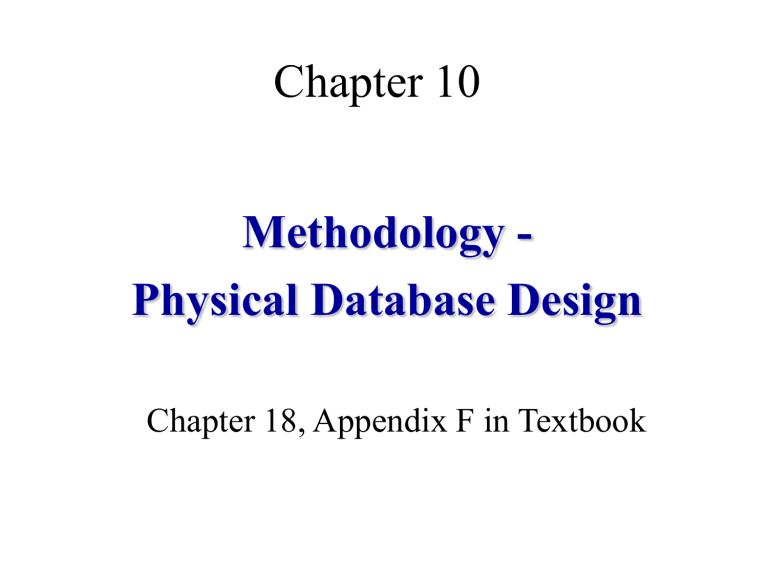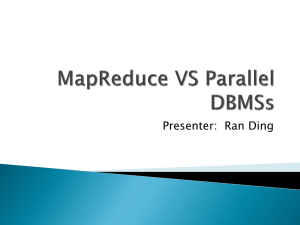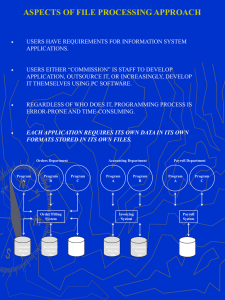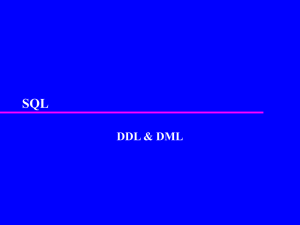Methodology – Physical Database Design

Chapter 10
Methodology -
Physical Database Design
Chapter 18, Appendix F in Textbook
Design Methodology Review
A structured approach that uses procedures, techniques, tools, and documentation aids to support and facilitate the process of design.
Conceptual DB Design 2
Database Design Review
Hardware independent
Software independent
Conceptual
DB design
Hardware independent
Software dependent
Logical
DB design
Hardware dependent
Software dependent
Physical
DB design
Physical DB Design 3
Design Methodology Overview Review
Step 1 Build local conceptual data model for each user view.
Step 2 Build and validate local logical data model for each view.
Step 3 Build and validate global logical data model.
Step 4 Translate global logical data model for target DBMS.
Step 5 Design physical representation.
Step 6 Design user views.
Step 7 Design security mechanisms.
Step 8 Consider the introduction of controlled redundancy.
Step 9 Monitor and tune the operational system.
Physical DB Design 4
Comparison of Logical and
Physical Database Design
Logical database design is concerned with the what ,
Physical database design is concerned with the how .
Process of producing a description of the implementation of the database on secondary storage; it describes the base relations, file organizations, and indexes used to achieve efficient access to the data, and any associated integrity constraints and security measures.
Physical DB Design 5
Overview of Physical Database
Design Methodology
Step 4 Translate global logical data model for target DBMS
Step 4.1 Design base relations
Step 4.2 Design representation of derived data
Step 4.3 Design enterprise constraints
Step 5 Design physical representation
Step 5.1 Analyze transactions
Step 5.2 Choose file organizations
Step 5.3 Choose indexes
Step 5.4 Estimate disk space requirements
Physical DB Design 6
Overview of Physical Database
Design Methodology
Step 6 Design user views
Step 7 Design security mechanisms
Step 8 Consider the introduction of controlled redundancy
Step 9 Monitor and tune the operational system
Physical DB Design 7
Step 4 Translate Global Logical
Data Model for Target DBMS
Objective: To produce a relational database schema that can be implemented in the target DBMS from the global logical data model.
Need to know functionality of target DBMS such as how to create base relations and whether the system supports the definition of:
– PKs, FKs, and AKs;
– required data (NOT NULL);
– domains;
– relational integrity constraints;
– enterprise constraints.
Physical DB Design 8
Step 4.1 Design Base Relations
Objective: To decide how to represent base relations identified in global logical model in target DBMS.
For each relation, need to define:
– the name of the relation;
– a list of simple attributes in brackets;
– the PK and, where appropriate, AKs and FKs.
– a list of any derived attributes and how they should be computed;
– referential integrity constraints for any FKs identified.
Physical DB Design 9
Step 4.1 Design Base Relations
For each attribute, need to define:
– its domain, consisting of a data type, length, and any constraints on the domain;
– an optional default value for the attribute;
– whether the attribute can hold nulls.
Physical DB Design 10
PropertyForRent Relation
Domain PropertyNumber: variable length character string, length 5
Domain street: variable length character string, length 25
:
Domain city: variable length character string, length 15
PROPERTYFORRENT( propertyNo PropertyNumber NOT NULL,
Street street NOT NULL,
City city NOY NULL,
:
PRIMARY KEY(propertyNo),
FOREIGN KEY (staffNo) REFERENCES staff(staffNO)
ON UPDATE CASCADE ON DELETE SET NULL,
FOREIGN KEY (ownerNo) REFERENCES POwner(ownerNO)
ON UPDATE CASCADE ON DELETE SET NULL);
Physical DB Design 11
Step 4.2 Design Representation of
Derived Data
Objective: To decide how to represent any derived data present in the global logical data model in the target DBMS.
Derived attribute can be stored in database or calculated every time it is needed.
Option selected is based on:
– additional cost to store the derived data and keep it consistent with operational data from which it is derived;
– cost to calculate it each time it is required.
Physical DB Design 12
Physical DB Design
STAFF
StaffNo
SL21
SG37
SG14
SA9
SG5
SL41
FName LName BrnNo NoPro
John
Ann
David
Mary
Susan
Julie
White
Beech
Ford
Howe
Brand
Lee
B005
B003
B003
B007
B003
B005
1
1
0
0
2
1
13
Step 4.3 Design Enterprise
Constraints
Objective: To design the enterprise constraints for the target DBMS.
Some DBMS provide more facilities than others for defining enterprise constraints.
Example:
CONSTRAINT StaffNotHandlingTooMuch
CHECK (NOT EXISTS (SELECT staffNo
FROM PropertyForRent
GROUP BY staffNo
HAVING COUNT(*) > 100))
Physical DB Design 14
Step 5 Design Physical
Representation
Objective: To determine optimal file organizations to store the base relations and the indexes that are required to achieve acceptable performance; that is, the way in which relations and tuples will be held on secondary storage.
Physical DB Design 15
Step 5 Design Physical
Representation
Number of factors that may be used to measure efficiency:
Transaction throughput: number of transactions processed in given time interval.
Response time: elapsed time for completion of a single transaction.
Disk storage: amount of disk space required to store database files.
However, no one factor is always correct. Typically, have to trade one factor off against another to achieve a reasonable balance.
Physical DB Design 16
Step 5.1 Analyze Transactions
Objective: To understand the functionality of the transactions that will run on the database and to analyze the important transactions.
Attempt to identify performance criteria, such as:
– transactions that run frequently and will have a significant impact on performance;
– transactions that are critical to the business;
– times during the day/week when there will be a high demand made on the database (called the peak load ).
Physical DB Design 17
Step 5.1 Analyze Transactions
Use this information to identify the parts of the database that may cause performance problems.
To select appropriate file organizations and indexes, also need to know high-level functionality of the transactions, such as:
• attributes that are updated in an update transaction;
• criteria used to restrict tuples that are retrieved in a query.
Often not possible to analyze all expected transactions, so investigate most
‘important’ ones.
Physical DB Design 18
Step 5.1 Analyze Transactions
To focus on areas that may be problematic:
(1) Map all transaction paths to relations.
(2) Determine which relations are most frequently accessed by transactions.
(3) Analyze the data usage of selected transactions that involve these relations.
Physical DB Design 19
Transaction’s Pathways for Global View
StaffNo
(b)
OwnerNo
PRIVATE
OWNER
OWNER
SUPERVISOR
(1,*)
STAFF register
(0,*)
(a)
(0,100) (e)
(d) manage
(c,g)
PropertyNo
BOwn
(0,1)
(1,1)
PROPERTY
(0,*)
(0,*)
VDate views
(h,i)
Comment
(0,*)
(1:1)
CLIENT
(0,*) (1:1) d
(l) associate hold state
BUSINESS
OWNER
(1:1) (j) (1:1)
LeaseNo LEASE PREFERENCE
(1:1)
(m)
ClientNo
(k)
Transaction Usage Map
STAFF
2000
Avg = 20
Max= 40 (C)
has
BRANCH
100
Avg = 50
Max= 100
(E)
manage
(F)
PROPERTY
100000
offer
Avg = 1000
Max= 3000
(D)
Physical DB Design 21
Transaction Analysis Form
22
Step 5.2 Choose File Organizations
Objective: To determine an efficient file organization for each base relation.
File organizations include:
• Heap (unordered)
• Ordered
• Hash
• Indexed Sequential Access Method (ISAM)
• B+-Tree
Physical DB Design 23
Indexes
A data structure that allows the DBMS to locate particular records in a file more quickly and thereby speed response to user queries.
Types of Indexes:
• Primary Index : the data file is sequentially ordered by an ordering key field, and the indexing field is built on the ordering key field (unique).
• Clustering Index : the data file is sequentially ordered on a non-key field (not distinct), and the indexing field is built on this non-key field ( clustering attribute ).
• Secondary Index : an index that is defined on a non-ordering field of the data file (distinct or not).
A file can have at most 1 primary index or clustering index, and several secondary indexes.
24
Index Example
STAFF
SG14
SG37
SL21
SL41
John
Ann
David
Mary
White
Beech
18000
12000
Ford
Howe
30000
9000
B005
B003
B003
B007
Data File
Of any file organization
(brnNo)
B003
B003
B005
B007
Index File ordered
Physical DB Design 25
Primary Index Example
index
S5 1
S14 2
S37 3
Data file
S5 Record
S9 Record
S14 Record
S21 Record
S37 Record
S41 Record page
1
2
3
Anchor record
Physical DB Design 26
Physical DB Design
Cluster Index Example
index
S5 1
S14 2
S21 3
Data file
S5 Record
S5 Record page
1
S14 Record
S14 Record
S14 Record
S21 Record
2
3
27
Indexes
(salary, brnNo)
9000, B007
12000,B003
18000,B005
30000,B003
STAFF
StaffNo
SG14
SG37
SL21
SL41
FName LName Salary
BrnNo
John
Ann
David
Mary
White
Beech
Ford
Howe
18000
12000
30000
9000
B005
B003
B003
B007
(salary)
9000
12000
18000
30000
Physical DB Design 28
Dense index
Index Categories
index
S5 1
S9 1
S14 2
S21 2
S37 3
S41 3
Data file
S5 Record
S9 Record
S14 Record
S21 Record
S37 Record
S41 Record page
1
2
3
Sparse index index
S5 1
S14 2
S37 3
Data file
S5 Record
S9 Record
S14 Record
S21 Record
S37 Record
S41 Record page
1
2
3
Physical DB Design 29
Level 2 Index
S5
S37
Multilevel Index
Level 1 Index
S5
S14
S37
S56
Data file
S5 Record
S9 Record
S14 Record
S21 Record
S37 Record
S41 Record
S56 Record
S87 Record page
1
2
3
4
Physical DB Design 30
Step 5.3 Choose Indexes
Objective: To determine whether adding indexes will improve the performance of the system.
Two approaches:
• Keep tuples unordered and create many secondary indexes.
• Order tuples in the relation by specifying a primary or clustering index.
Choose the attribute for ordering the tuples as:
– attribute that is used most often for join operations.
– attribute that is used most often to access the tuples in a relation in order of that attribute.
Example:
CREATE UNIQUE INDEX PropertyNoInd ON PropertyForRent(PNo);
CREATE INDEX StaffNoInd ON PropertyForRent(StaffNo) CLUSTER;
31
Choose Secondary Indexes
• Overhead involved in maintenance and use of secondary indexes that has to be balanced against performance improvement gained when retrieving data. This includes:
– adding an index record to every secondary index whenever tuple is inserted;
– updating a secondary index when corresponding tuple is updated;
– increase in disk space needed to store the secondary index.
Physical DB Design 32
Guidelines for Choosing Indexes
(1) Do not index small relations.
(2) Index PK of a relation if it is not a key of the file organization.
(3) Add secondary index to a FK if it is frequently accessed.
(4) Add secondary index to any attribute that is heavily used as a secondary key.
(5) Add secondary index on attributes that are involved in: selection or join criteria; ORDER BY; GROUP BY; and other operations involving sorting
(such as UNION or DISTINCT).
Physical DB Design 33
Guidelines for Choosing Indexes
(6) Add secondary index on attributes involved in built-in functions.
SELECT branchNo, AVG(salary)
FROM Staff
GROUP BY branchNo;
(7) Add secondary index on attributes that could result in an index-only plan .
(8) Avoid indexing an attribute or relation that is frequently updated.
(9) Avoid indexing an attribute if the query will retrieve a significant proportion of the tuples in the relation.
(10) Avoid indexing attributes that consist of long character strings.
Physical DB Design 34
Physical DB Design
Additional Indexes
Table
Staff
Client
PropertyForRent
Index
FName, LName
SupervisorStaffNo
Position
StaffNo
FName, LName
OwnerNo
StaffNo
ClientNo
RentFinish
City
Rent
ClientNo Viewing
35
Step 5.4 Estimate Disk Space
Requirements
Objective: To estimate the amount of disk space that will be required by the database.
Estimating the disk usage is highly dependent on the target DBMS and hardware used to support the database.
The estimate is based on:
– Size of each tuple.
– Maximum number of tuples in each relation (i.e. Consider how the relation will grow to estimate the Max potential size).
Physical DB Design 36
Step 6 Design User Views
Objective: To design the user views that were identified during the Requirements
Collection and Analysis stage of the relational database application lifecycle.
User view play a major role in enforcing security, especially in multi-user DBMS.
The major advantages of user view:
• Data independence.
• Reduce complexity.
• Customization.
Physical DB Design 37
Step 7 Design Security Measures
Objective: To design the security measures for the database as specified by the users during the development life cycle.
Relational DBMS provide two type of security:
•
System Security : covers access and use of the database at the system level, such as user name and password.
• Data Security : covers access and use of database objects, such as a relation or view, and the action that users can have on that objects.
Physical DB Design 38
Step 8 Consider the introduction of controlled redundancy
Objective: To determine whether introducing redundancy in a controlled manner by relaxing the normalization rules will improve the performance of the system.
This step should be undertaken only if necessary, because of the inherited problems involved in introducing redundancy while still maintaining consistency.
Physical DB Design 39
Step 9 Monitor and tune the operational system
Objective: To monitor the operational system and improve the performance of the system to correct inappropriate design decisions or reflect changing requirements.
Its an ongoing process of monitoring the operational system.
Physical DB Design 40









